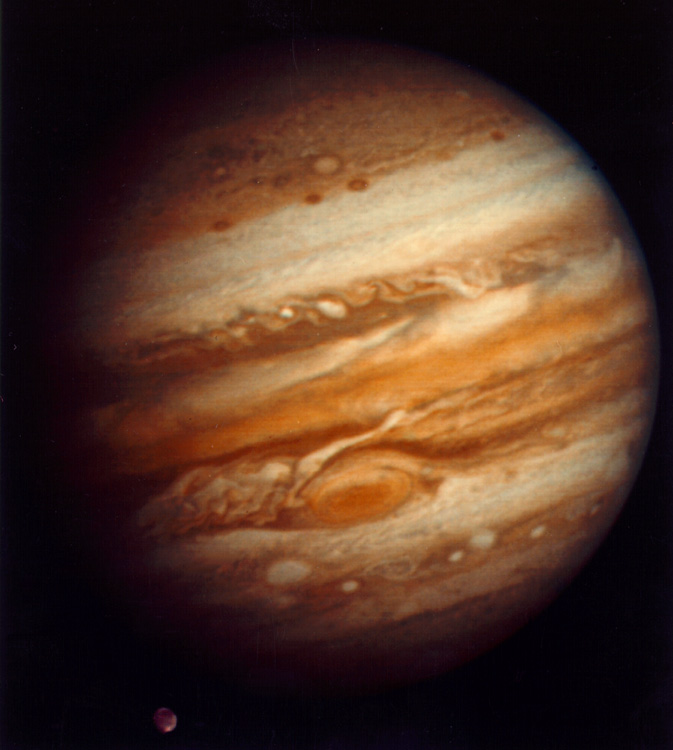What Voyager 1 Learned at Jupiter 40 Years Ago
It was 40 years ago today (March 5) that Voyager 1 flew past Jupiter, revealing a surprising planetary system that includes moons of ice and fire. And scientists are still looking at some of these moons for signs of habitability for microbes.
Voyager 1 and its twin spacecraft, Voyager 2, both left Earth in 1977 on the trail of an unusual planetary alignment that happens every 175 years, according to NASA. The gas giant planets Jupiter, Saturn, Uranus and Neptune lined up in such a way that a spacecraft could use the gravitational field of one planet to swing on to the next. Voyager 2 flew past all four planets, while Voyager 1 instead traveled high above the plane of the solar system after visiting Jupiter and Saturn.
Between them, the two spacecraft garnered basic knowledge about these large planets — measuring their atmospheres, their ring systems, their magnetic fields (including Jupiter's especially strong one) and how their inner cores may function. Jupiter had already been visited by the Pioneer spacecraft, but it still held surprises for Voyager 1 when it flew by in 1979.
Related: Voyager 1's Most Amazing Photos of Jupiter
Related: Voyager at 40: 40 Photos from NASA's Epic 'Grand Tour' Mission
"Jupiter's atmosphere was found to be more active than during the visits of Pioneer 10 and 11, sparking a rethinking of the earlier atmospheric models which could not explain the new features. The spacecraft imaged the moons Amalthea, Io, Europa, Ganymede and Callisto, showing details of their terrain for the first time," NASA officials said in a statement.
"Possibly the most stunning of Voyager 1's discoveries was that Io has extremely active volcanoes, powered by heat generated by the stretching and relaxing the moon endures every 42 hours as its elliptical orbit brings it closer to and then farther from Jupiter," NASA officials added. "The spacecraft also discovered a thin ring around the planet (then making it the second planet known to have a ring), and two new moons: Thebe and Metis."
Breaking space news, the latest updates on rocket launches, skywatching events and more!
Io's volcanic plumes are now being imaged regularly by NASA's Juno spacecraft. And Voyager's discoveries at Europa, Ganymede and Callisto will soon result in a more close-up examination of these bodies. These moons have icy surfaces and probable global oceans underneath, according to joint observations from the Voyager spacecraft, Galileo mission (which orbited Jupiter between 1995 and 2002); and even the Hubble Space Telescope, which spotted periodic spurts of what appears to be water emanating from Europa. Thanks to the intense flexing these moons' interiors receive as they orbit Jupiter, it's possible that the oceans host all the ingredients necessary for life. But scientists need more spacecraft observations to confirm this.
NASA is hard at work on the Europa Clipper, which is expected to go into orbit around Europa in the 2030s to see if this icy moon is host to conditions that could support microbial life. The European Space Agency's JUpiter ICy moons Explorer (JUICE) mission will launch from Earth in 2022 to study all three icy moons, but most especially Ganymede. JUICE will study the moons' oceans, ice layers and general geology, as well as learn more about their exospheres (tenuous atmospheres) and magnetic fields.
- 5 Facts About NASA's Far-Flung Voyager Spacecraft
- Voyager 1 Just Fired Up its Backup Thrusters for the 1st Time in 37 Years
- Massive Storms Swirl on Jupiter in This Awesome NASA Photo
Follow Elizabeth Howell on Twitter @howellspace. Follow us on Twitter @Spacedotcom and on Facebook.

Elizabeth Howell (she/her), Ph.D., was a staff writer in the spaceflight channel between 2022 and 2024 specializing in Canadian space news. She was contributing writer for Space.com for 10 years from 2012 to 2024. Elizabeth's reporting includes multiple exclusives with the White House, leading world coverage about a lost-and-found space tomato on the International Space Station, witnessing five human spaceflight launches on two continents, flying parabolic, working inside a spacesuit, and participating in a simulated Mars mission. Her latest book, "Why Am I Taller?" (ECW Press, 2022) is co-written with astronaut Dave Williams.

